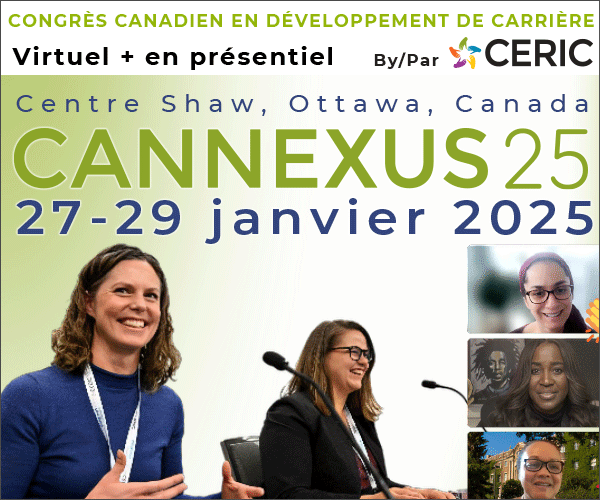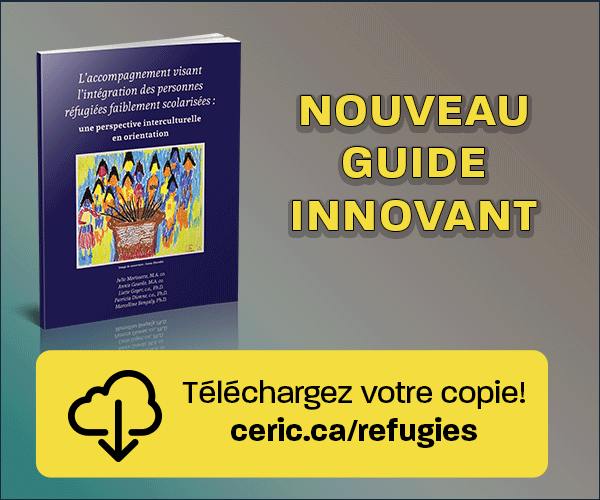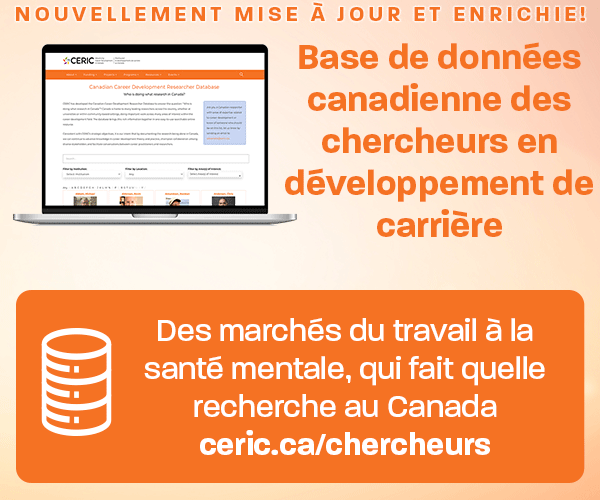Le dilemme de l’année sabbatique. Quand une année sabbatique réfléchie est la réponse à un manque de préparation relatif à la carrière
Mots-clés :
année sabbatique, carrière, impréparation, post-secondaire, étudiantsRésumé
Students entering post-secondary are shown to be increasingly underprepared for the educational and career related demands associated with higher education. Quickly becoming a global trend and an attractive alternative to entering post-secondary directly from high school, a purposeful gap year increases student academic motivation and performance. Despite gaining popularity, there is limited research exploring the implications of the gap year among a North American population. The present study sought to examine how university students come to make career choices and the implications that a gap year has for this process. Two hundred first year undergraduate students studying at a large university in Western Canada completed a survey about their career plans. An analysis of the results comparing gap year and non-gap year students using a non-parametric ANOVA revealed that while students who had taken a gap year benefited from enhanced personal experiences and indicated that taking this time out of school was a positive experience, they continued to lack confidence and clarity regarding their career plans. These and other findings are discussed and serve to enhance an understanding of the potential benefits and implications of a purposeful gap year
Références
American Gap Association. (2012). Gap year data & benefits. Retrieved from http://www.apastyle.org/learn/quick-guideon-references.aspx
Ball, S., Vincent, C., Kemp, S., & Pietikainen S. (2004). Middle class fractions, childcare and the “relational” and “normative” aspects of class practices. Sociological Review, 52, 478-502.
Berkner, L., He, S., Forrest-Cataldi, E., & Knepper P. (2003). Descriptive summary of 1995-96 beginning postsecondary students: Six years later (Report No. 2003-151).
Washington, DC: U.S. Department of Education, National Center for Education Statistics.
Birch, E. B., & Miller P. W. (2007). The characteristics of “gapyear” students and their tertiary academic outcomes. Economic Record, 83, 329-344.
Bloxom, J. M., Bernes, K. B., Magnusson, K. C., Gunn, T. T., Bardick, A. D., Orr, D. T., & McKnight, K. M. (2008). Grade 12 students career needs and perceptions of the effectiveness of career development services within high schools. Canadian Journal of Counselling, 42, 79- 100.
Briggs, A. R. J., Clark, J., & Hall, I. (2012). Building bridges: Understanding student transition to university. Quality in Higher Education, 18, 3-21.
Brown, P., & Hesketh, A. J. (2004). The mismanagement of talent: Employability and jobs in the knowledge economy. Oxford, ENG: Oxford University Press.
Brown, P., Hesketh, A. J., & Williams P. (2003). Employability in a knowledge-driven economy. Journal of Education and Work, 16, 107-126.
Canadian Information Centre for International Credentials. (2009, February). Postsecondary Education Systems in Canada: An Overview. Retrieved from: http://www.cicic.ca/421/an-overview.canada
Cappel, J. J. (2001). Entry-level IS job skills: A survey of employers. The Journal of Computer Information Systems, 42, 76-82.
Cherry, N. & Gear, R. (1987). Young people’s perceptions of their vocational guidance needs: Priorities and pre-occupations. British Journal of Guidance & Counselling, 15, 59-71.
Christie, H., Munro, M., & Fisher T. (2004). Leaving university early: exploring the differences between continuing and non-continuing students. Studies in Higher Education, 29, 617-636.
Code, M. N., Bernes, K. B., Gunn, T. M., & Bardick, A. D. (2006). Adolescents’ perceptions of career concern: Student discouragement in career development. Canadian Journal of Counselling, 40, 160-174.
Council of Alberta University Students. (2011, June). Securing Alberta’s future: How Alberta can lead in post-secondary education. Retrieved from: http://www.caus.net/docs/11-06_Vision.pdf
Creed, P. A., & Patton W. (2003). Predicting two components of career maturity in school based adolescents. Journal of Career Development, 29, 277-290.
Curtis, D. D. (2014). The ‘gap year’ in Australia: Incidence, participant characteristics and outcomes. Australian Economic Review, 47, 107-114.
Gray, D. A., Gault, F. M., Meyers, H. H., & Walther, J. E. (1990). Career planning. Prevention inHuman Services, 8, 43-59.
Gysbers, N. C., & Lapan, R. T. (2009). Strengths-based career development for school guidance and counselling programs. Chelsea, MI: Counselling Outfitters.
Haigler, K., & Nelson R. (2005). The gap-year advantage: Helping your child benefit from time off before or during college. New York, NY: St. Martin’s Griffin.
Hansen, E. J. (1998). Essential demographics of today’s college students. AAHE Bulletin, 51, 3-5.
Harvey, L. (2000). New realities: The relationship between higher education and employment. Tertiary Education and Management, 6, 3-17.
Heath, S. (2007). Widening the gap: Pre-university gap years and the “economy of experience.” British Journal of Sociology of Education, 28, 89-103.
Hirschi, A. (2011). Career-choice readiness in adolescence: Developmental trajectories and individual differences. Journal of Vocational Behaviour, 79, 340-348.
Hoover, E. (2001). More students decide that college can wait. Chronicle of Higher Education, 48, 51-52.
Jansen, E. P. W. A., & Van der Meer, J. (2012). Ready for university? A cross-national study of students’ perceived preparedness for university. The Australian Educational Researcher, 39, 1-16.
Jones, A. (2004). Review of gap year provision (Research Brief No. RB555). London, ENG: Department for Education and Skills.
King, A. (2011). Minding the gap? Young people’s accounts of taking a gap year as a form of identity work in higher education. Journal of Youth Studies, 14, 341-357.
Magnusson, K., & Bernes, K. (2002). Comprehensive Career Needs Survey: An overview. Alberta Counsellor, 27, 12-15.
Martin, A. J. (2010). Should students have a gap year? Motivation and performance factors relevant to time out after completing school. Journal of Educational Psychology, 102, 561-576.
McEniry, P. (2008). Gap year. Melbourne, AU: Brolga Publishing. Munro, D., MacLaine, C., & Stucky, J. (2014). Skills – Where are we today? The state of skills and PSE in Canada. Ottawa, ON: The Conference Board of Canada.
Nel, C., Troskie-de Bruin, C., & Bitzer, E. (2009). Students’ transition from school to university: Possibilities for a pre-university intervention. South African Journal of Higher Education, 23, 974-991.
Pancer, S. M., Pratt, M., Hunsberger, B., & Alisat, S. (2004). Bridging troubled waters: Helping students make the transition from high school to university. Guidance and Counselling, 19, 184-190.
Power, S., Edwards, T., Whitty, G., & Wigfall V. (2003). Motivation in education: Theory, research, and applications (2nd ed.). Englewood Cliffs, NJ: Prentice Hall Merrill.
Reay, D., David, M., & Ball S. (2005). Degrees of choice: Social class, race and gender in higher education. Stoke-on-Trent, ENG: Trentham Books.
Saunders, V., & Zuzel, K. (2010). Evaluation employability skills: Employer and student perceptions. Bioscience Education, 15, 1-10.
Sears, A. (2004). Mind the gap: Prospects for easing the transition from high school to university. Guidance & Counselling, 19, 166-172.
Shaienks, D., Gluszynski, T., & Bayard, J. (2008). Postsecondary education, participation and dropping out: Differences across university, college and other types of postsecondary institutions (Report No. 81-595-M-070). Ottawa, ON: Statistics Canada.
Skorikov, V. B. (2007). Continuity in adolescent career preparation and its effects on adjustment. Journal of Vocational Behaviour, 70, 8-24.
Stehlik, T. (2010). Mind the gap: School leaver aspirations and delayed pathways to further and higher education. Journal of Education & Work, 23, 363-376.
Strauss, V. (2012, September 21). What ‘gap’ years are all about. The Washington Post. Retrieved from http://www.washingtonpost.com/blogs/answer-sheet/post/a-primer-ongap-years/2012/09/20/005d2a5c033f-11e2-91e7-2962c74e7738_blog.html
Stringer, K., Kerpelman, J., & Skorikov, V. (2012). A longitudinal examination of career preparation and adjustment during the transition from high school. Developmental Psychology, 48, 1343-1354.
Tansey, E., & Keane, A. (2012). An experiential transition day for the biosciences: Preparing second level students for entry to university life. Bioscience Education, 19, 92-100.
White, K. M. (2009). The complete guide to the gap year: The best things to do between high school and college. San Francisco, CA: Jossey-Bass.
Wilensky, R. (2007). High schools have got it bad for higher ed: And that ain’t good. The Phi Delta Kappan, 89, 248-259.

Téléchargements
Publié-e
Comment citer
Numéro
Rubrique
Licence

Cette œuvre est sous licence Creative Commons Attribution - Pas d'Utilisation Commerciale - Pas de Modification 4.0 International.











